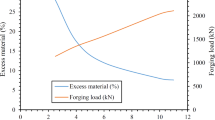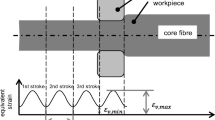Abstract
Closed-die forging preforms are usually made by open die forging operations, which are subject to significant variabilities. A sensitivity study covering a wide range of influencing parameters has highlighted the predominant influence of the initial billet geometry. The forging die strokes were also highly influential, while their fidelity is sufficient to use them as control parameters in order to compensate the geometrical dispersions of the billet. Consequently, their optimization was performed by taking a nominal preform geometry as the target. Polynomial surrogate models have been constructed to enable real-time optimization. A specific preform was used as a demonstrator in this study, while the approach was generic. The surrogate models were built using data from finite element simulations, which were first validated with an experimental campaign. On the one hand, this approach introduced agility by allowing changes in the billet geometry, and on the other hand, it allowed individual customization of the specific route to each billet.












Similar content being viewed by others
Data Availability
The data are not available.
Code availability
The finite element simulations were performed with the FORGE.NxT\(\copyright \) commercial Software. No code was specifically developed to obtain the results presented in the article.
References
Pater Z, Tomczak J, Bulzak T, Walczuk-Ga̧gała P (2022) Numerical and experimental study on forming preforms in a CNC skew rolling mill. Archiv Civil Mech Eng 22:54
Domblesky J, Kraft F, Druecke B, Sims B (2006) Welded preforms for forging. J Mater Process Technol 171:141–149
Li F, Chen P, Han J, Deng L, Yi J, Liu Y, Eckert J (2020) Metal flow behavior of P/M connecting rod preform in flashless forging based on isothermal compression and numerical simulation. J Mater Res Technol 9:1200–1209
Shao Y, Lu B, Xu DK, Chen J, Ou H, Long H, Guo PY (2016) Topology-based preform design optimization for blade forging. Int J Adv Manufac Technol 86:1593–1605. https://doi.org/10.1007/s00170-015-8263-z
Knust J, Podszus F, Stonis M, Behrens BA, Overmeyer L, Ullmann G (2017) Preform optimization for hot forging processes using genetic algorithms. Int J Adv Manufac Technol 89(5):1623–1634. https://doi.org/10.1007/s00170-016-9209-9
Biba N, Vlasov A, Krivenko D, Duzhev A, Stebunov S (2020) Closed die forging preform shape design using isothermal surfaces method. Procedia Manufac 47:268–273. https://doi.org/10.1016/j.promfg.2020.04.219
Zheng J, Frey HC (2004) Quantification of variability and uncertainty using mixture distributions: evaluations of sample size, mixing weights, and separation between components. Risk Anal 24(3):553–571. https://doi.org/10.1111/j.0272-4332.2004.00459.x
Arentoft M, Wanheim T (1997) The basis for a design support system to prevent defects in forging. J Mater Process Technol 69:227–232. https://doi.org/10.1016/S0924-0136(97)00023-X
Allam Z, Becker E, Baudouin C, Bigot R, Krumpipe P (2013) A generic methodology to improve the control of forging process parameters. Key Eng Mater 554–557:2138–2144. https://doi.org/10.4028/www.scientific.net/KEM.554-557.2138
Saltelli A, Tarantola S, Campolongo F (2000) Sensitivity analysis as an ingredient of modeling. Stat Sci 15(4):377–395
Schwarz C, Ackert P, Mauermann R (2018) Principal component analysis and singular value decomposition used for a numerical sensitivity analysis of a complex drawn part. Int J Adv Manufac Technol 94:2255–2265. https://doi.org/10.1007/s00170-017-0980-z
Belur BK, Grandhi RV (2004) Geometric deviations in forging and cooling operations due to process uncertainties. J Mater Process Technol 152:204–214
Cochet J, Thuillier S, Decultot N, Manach PY (2017) Investigation of the key process parameters in the hot forging of a shackle. Int J Adv Manufac Technol 105:3209–3219. https://doi.org/10.1007/s00170-019-04451-1
Srivastava SK, Srivastava K, Sharma RS, Kandikonda HR (2004) Modelling of hot closed die forging of an automotive piston with ANN for intelligent manufacturing. J Sci Indust Res 63:997–1005
Wiebenga JH, Van den Boogaard AH (2014) On the effect of numerical noise in approximate optimization of forming processes using numerical simulations. Int J Mater Forming 7:317–335. https://doi.org/10.1007/s12289-013-1130-2
Slimani K, Zaaf K, Balan T (2023) Accurate surrogate models for the flat rolling process. Int J Mater Forming 16(2). https://doi.org/10.1007/s12289-023-01744-5
Wei D, Cui Z, Chen J (2008) Optimization and tolerance prediction of sheet metal forming process using response surface model. Comput Mater Sci 42(2):228–233. https://doi.org/10.1016/j.commatsci.2007.07.014
Bonte M, Fourment L, Do T, Van den Boogaard AH, Huétink J (2010) Optimization of forging processes using finite element simulations : a comparison of sequential approximate optimization and other algorithms. Struct Multidisciplinary Optimization 42:797–810. https://doi.org/10.1007/s00158-010-0545-3
Meng F, Labergere C, Lafon P, Duguy M, Daniel L (2014) Multi-objective optimization based on meta-models of an aeronautical hub including the ductile damage constraint. Int J Damage Mech 23(8):1055–1076
Huang C, Radi B, El Hami A (2016) Uncertainty analysis of deep drawing using surrogate model based probabilistic method. Int J Adv Manufac Technol 86:3229–3240. https://doi.org/10.1007/s00170-016-8436-4
Ou H, Wang P, Lu B, Long H (2012) Finite element modelling and optimisation of net-shape metal forming processes with uncertainties. Comput Struc 90–91:13–27. https://doi.org/10.1016/j.compstruc.2011.10.014
Wiebenga JH, Atzema EH, Van den Boogaard AH (2015) Stretching the limits of forming processes by robust optimization: a numerical and experimental demonstrator. J Mater Process Technol 217:345–355
Zhu F, Wang Z, Lv M (2016) Multi-objective optimization method of precision forging process parameters to control the forming quality. Int J Adv Manufac Technol 83:1763–1771. https://doi.org/10.1007/s00170-015-7682-1
Equbal MI, Kumar R, Shamim M, Ohdar RK (2014) A grey-based Taguchi method to optimize hot forging process. Procedia Mater Sci 6:1495–1504. https://doi.org/10.1016/j.mspro.2014.07.129
Forge NxT 3.2 software, user manual. viewed on 09/10/2023
Acknowledgements
The authors are grateful to Stéphane Beinstingel and Olivier Gyss from Setforge Bouzonville for their technical contribution. The financial support from the Région Grand Est (France) and the FEDER - fond européen de développement régional - through the SAFIRE project is gratefully acknowledged.
Funding
This work was supported by the REGION GRAND-EST and the European Regional Development Fund.
Author information
Authors and Affiliations
Corresponding author
Ethics declarations
Conflict of interest
The authors declare no competing interests.
Ethics approval
The authors of the article approve the ethical rules of the journal. They ensure that all the instructions of the session “Ethical Responsibilities of Authors” of “ the instruction for Authors statements” available on the IJAMT website were followed.
Consent to participate
Not applicable
Consent for publication
Not applicable
Additional information
Publisher's Note
Springer Nature remains neutral with regard to jurisdictional claims in published maps and institutional affiliations.
Rights and permissions
Springer Nature or its licensor (e.g. a society or other partner) holds exclusive rights to this article under a publishing agreement with the author(s) or other rightsholder(s); author self-archiving of the accepted manuscript version of this article is solely governed by the terms of such publishing agreement and applicable law.
About this article
Cite this article
Fays, S., Baudouin, C., Langlois, L. et al. Compensation of billet variabilities through metamodel-based optimization in open die forging. Int J Adv Manuf Technol 132, 1665–1678 (2024). https://doi.org/10.1007/s00170-024-13392-3
Received:
Accepted:
Published:
Issue Date:
DOI: https://doi.org/10.1007/s00170-024-13392-3




